St John's Anglican Church
St John's Avenue, New Town
First organ, moved to Hobart. St John's Uniting (Presbyterian) Church.
Present organ, B. 1886 Hill & Son, London (job no. 1929).
2m., 18 sp.st., 3c., tr. Gt: 8.8.8.8.4.4.3.III.8. Sw: 16.8.8.8.4.2.8. Ped: 16.16.
Reb. 1955 Hill, Norman & Beard (o/n T334). Reb. 1977-78 Laurie Pipe Organs.
2m., 27 sp.st., 8c., el.pn. Gt: 16.8.8.8.8.4.4.2-2/3.2.1-3/5.III. Sw: 8.8.8.4.2.III.8.8.
Ped: 16.16.16.10-2/3.8.8.4.16.
Historical and Technical Documentation by John Maidment
© OHTA (last updated May 2011)

St John's Anglican Church, New Town : exterior showing tower
[photograph by Trevor Bunning (27 April 2011)]
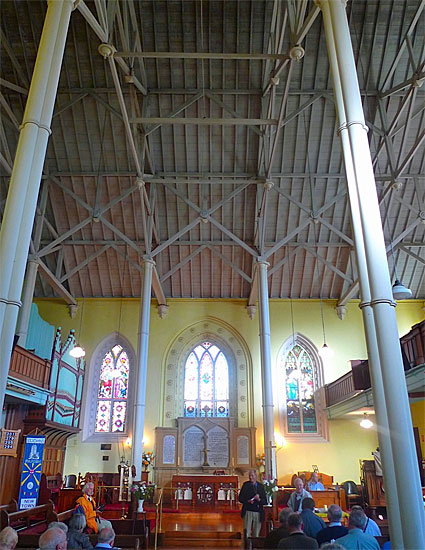
St John's Anglican Church, New Town : interior showing roof and organ to left
[photograph by Trevor Bunning (27 April 2011)]
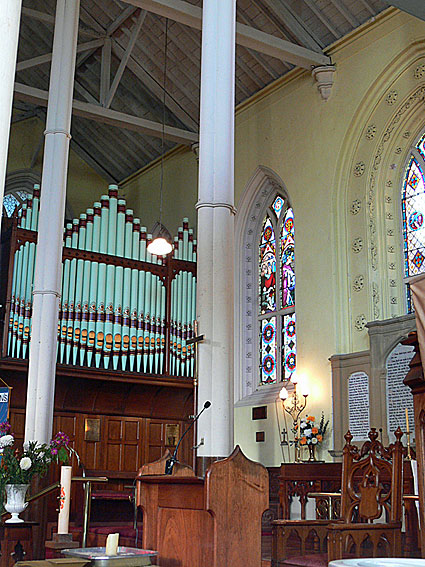
St John's Anglican Church, New Town :
The Hill & Son organ case
[photograph by John Maidment (27 April 2011)]

St John's Anglican Church, New Town : interior showing reredos and stained glass
[photograph by Trevor Bunning (27 April 2011)]
St John's Church was designed by the important early Tasmanian architect John Lee Archer and formed part of a wider complex of church and orphan schools. The foundation stone was laid on 6 January 1834, the church was consecrated on 29 May 1835 and opened for worship on 20 December 1835.1 This is a spacious stone building in a simplified Gothic idiom with a tall tower placed at the centre of the main facade. The interior has north and south galleries, one used for orphans and the other for convicts.
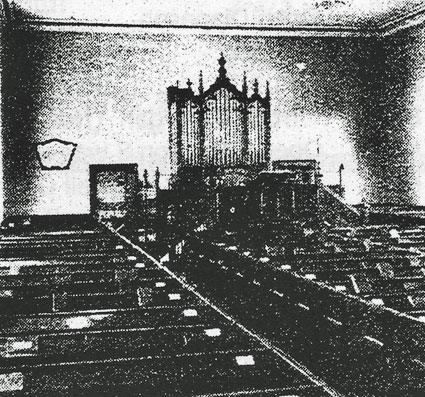
The original Gray & Davison organ shown at St John's Presbyterian Church, Hobart
[photograph from Historic Pipe Organs of Tasmania]
The first organ was built by Gray & Davison, London. It had a Gothic case in stained and varnished oak, with gilt facade pipes. The specification was as follows:
MANUAL
Open Diapason
Diapason Bass
Clarabella
Dulciana
Principal
Fifteenth
Sesqu[i]alt[era]
Pedal coupler
PEDAL
Bourdon
|
[8]
[8]
[8]
[8]
[4]
[2]
16
|
12 pipes
|
Two octaves of German pedals
The whole enclosed in a general swell2
This organ was sold to St John's Presbyterian Church, Macquarie Street, Hobart but was replaced by a new organ built in 1901 by Geo. Fincham & Son.

The Hill & Son organ before its rebuilding in 1955
[photograph kindly supplied by David Shield (8 November 2010)]
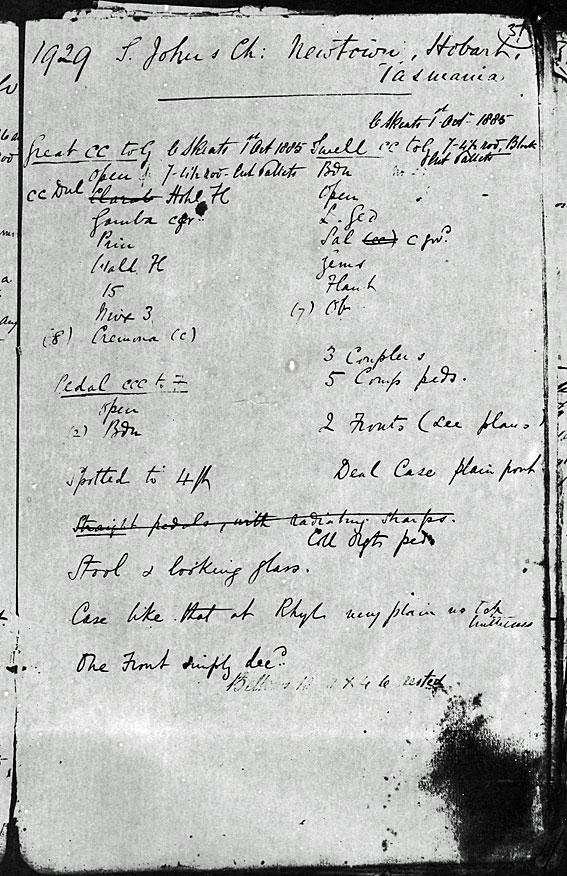
Order record for the Hill & Son organ
[kindly supplied by the British Organ Archive to OHTA]
The present organ was built by Hill & Son, London as the firm's job number 1929. The firm's order books record the following specification:3
Great CC to G C Skeats 1st Oct 1885 7-4 ½ rod cut pallets
Open 7
CC Dul
Clarab Hohl Fl
Gamba c gr
Prin
Wald Fl
15
Mix 3
Cremona CC
Swell CC to G C Skeats 1st Oct 1885 7-4 ½ rod, Block Cut Pallets
Bdn
Open
L. Ged
Sal (CC) c gvd.
Gems
Flaut
Ob
Pedal CCC to F
Open
Bdn
3 Couplers
5 Comp. Peds
2 Fronts (see plans)
Deal Case plain front
Spotted to 4ft
Straight pedals, with radiating sharps
Coll Orgts peds
Stool & looking glass.
Case like that at Rhyl very plain no top buttresses
One Front simply decd.
Bellows [illegible] x 4 6 rested
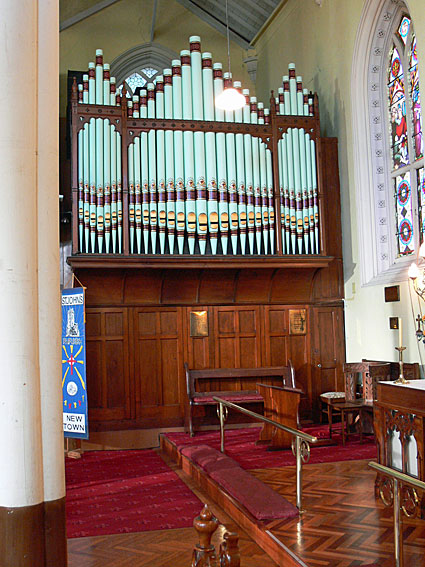
The Hill & Son organ case
[photograph by Trevor Bunning (27 April 2011)]

The Hill & Son organ case – upper section
[photograph by Trevor Bunning (27 April 2011)]
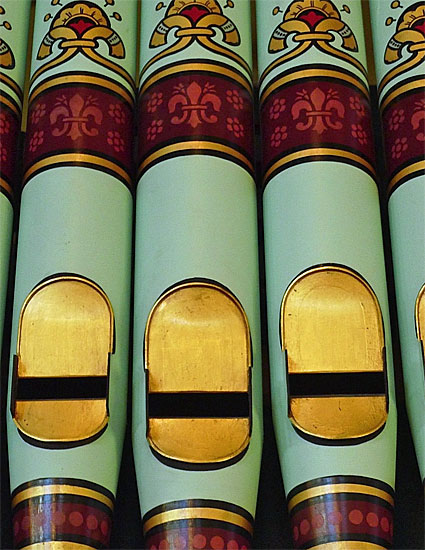
The Hill & Son organ case – detail of pipe decoration
[photograph by Trevor Bunning (27 April 2011)]
This organ was rebuilt in 1955 by Hill, Norman & Beard (Australia) Pty Ltd, of Clifton Hill, Victoria, the firm's job number T334. The mechanical action and attached console were discarded and replaced by a new electro-pneumatic action and detached console. Apart from the removal of the Hill & Son Cremona and the transfer of the Bourdon to the Great Organ, and the extension of several pedal registers, there were no other tonal changes.5 The case panels were carefully infilled so that there is no evidence of where the Hill & Son console was located. The organ was further rebuilt in 1977-78 by Laurie Pipe Organs Pty Ltd, of Moorabbin, Victoria when some further tonal changes were made including a full-length metal Bassoon 16ft to the Pedal Organ.. At some stage, the pipe mouths have been overpainted, removing the original border decoration.
The current specification follows:
GREAT
Bourdon
Open Diapason
Hohl Flute
Viola da Gamba
Dulciana
Principal
Wald Flute
Twelfth
Fifteenth
Tierce
Mixture 19.22.26
Swell Sub to Great
Swell to Great
Swell Super to Great
SWELL
Open Diapason
Gedeckt
Salicional
Gemshorn
Flageolet
Mixture 22.26.29
Trumpet
Oboe
Tremulant
Sub Octave
Unison Off
Super Octave
PEDAL
Open Wood
Subbass
Bourdon
Quint
Principal
Flute
Fifteenth
Bassoon
Great to Pedal
Swell to Pedal
|
16
8
8
8
8
4
4
2-2/3
2
1-3/5
III
8
8
8
4
2
III
8
8
16
16
16
10-2/3
8
8
4
16
|
A
TG 1978
revised
revoiced
1978
new *
B
A
B
C
B
C
1978
|
* This was the old Swell Horn stop from the 1884 J.W. Walker & Sons organ at St Andrew's Anglican Church, South Brisbane, rebuilt by the Laurie firm in 19705
The instrument still retains many of its Hill & Son characteristics and has fine choruses of considerable power speaking into a fine acoustic.

The Hill, Norman & Beard / Laurie Pipe Organs console – Dr Steven Nisbet performing
[photograph by Trevor Bunning (27 April 2011)]
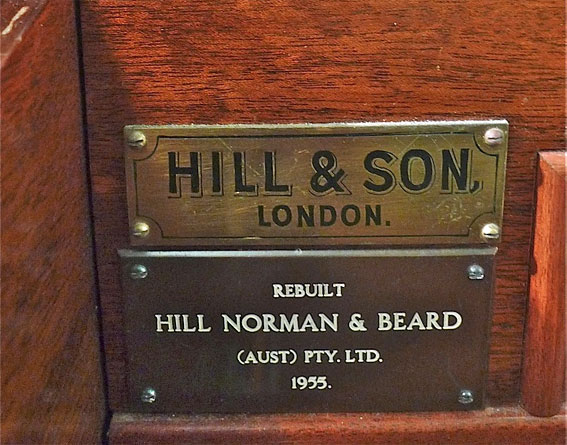
The Hill & Son and Hill, Norman & Beard nameplates
[photograph by Trevor Bunning (27 April 2011)]
1 Roy Smith, John Lee Archer: Tasmanian Architect and Engineer (s.l.: Tasmanian Historical Research Association, 1962), pp. 14, 17; E. Graeme Robertson, Early Buildings of Southern Tasmania, volume two (Melbourne: Georgian House, 1970), p.197
2 The Mercury, 30 November 1887, p.4
3 Hill & Son order books, housed at the British Organ Archive
4 Specification noted 1970 John Maidment
5 Specification noted 1979 John Maidment











